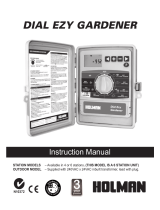Section 1: Introduction
Thank you for selecting an Orbit
®
sprinkler timer. Orbit
®
designers
have combined the simplicity and accuracy of digital electronics to
give you a timer that is both easy to program and extremely versatile.
The Orbit
®
timer provides convenience and flexibility, letting you
run a fully automatic, a semi-automatic, or a manual watering pro-
gram for all your watering needs.
Please read the manual completely before you install or use this
sprinkler timer.
To assist you, we have included some notable features to
this manual.
1. Glossary of the most common terms (see page 17)
2. Blue Text relates to the buttons used for programming
3. Blue Underlined Text relates to stop positions for both
rotary dial and slide switches.
Programming Features
Dual Programs
This Timer has two programs (“Program A” and “Program B”)
that allow you to set up separate watering schedules for your Lawn,
Gardens or Shrubs.
Fail-Safe Program
If the timer loses AC power, the existing program, date and time will
not be lost. After the AC power returns, the timer will recall the last
program into memory. If both the AC power is lost and the battery
is dead or missing, the user will have to reprogram the timer.
Water Budgeting
This feature is ideal when adjusting to seasonal watering demands.
Instead of reprogramming your timer, the “Water Budget Mode” will
enable easy adjustments to watering duration by ten percent incre-
ments from 10%-200%. For example, a budget percentage set at
70% will alter a 10-minute preset watering duration to 7 minutes.
Start-Time Stacking
When a start time is set before the previous program has completed,
that start time will be “stacked” or delayed, and will start upon
completion of the previous program.
Section 2: Getting Started
Programming the timer can be accomplished in just a few basic
steps. Before you begin programming, it is important to install the
battery, set the time of day and date, and establish a watering plan.
To activate battery, pull the narrow black plastic strip out, this
is protruding out the top panel.
Replacing the Battery
The timer requires one CR2032 Lithium battery to keep the program
in memory in case of AC power loss. In a typical installation, the
battery should provide sufficient power for approximately one year
of protection. Therefore, we recommend changing the battery every
year.
• Remove the battery cover by sliding it upward.
• Insert one CR2032 battery into the battery compartment.
• Return the battery cover to its closed position.
A weak or missing battery can cause the time, date, and program
to be erased after a power failure. If this happens, you will need to
install a fully charged battery and reprogram the timer.
Note: A battery alone will not operate the valves in your sprinkling
system. The sprinkler timer has a build-in transformer that must be con-
nected to an AC line voltage source.
Resetting the Sprinkler Timer
If this is the first time the sprinkler timer has been programmed, you
should press the small recessed button labeled RESET. Do not press
ENGLISH
3



















